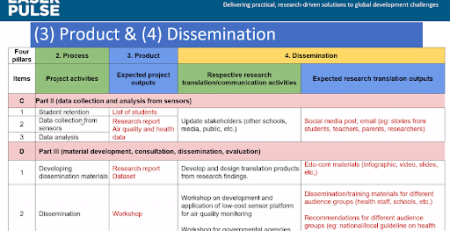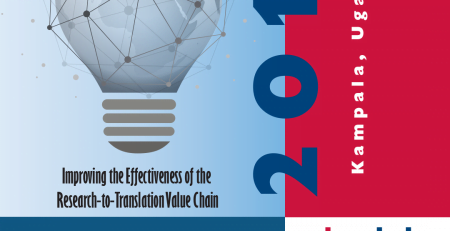Four key takeaways on early impact of LASER PULSE’s Embedded Research Translation (ERT) model on research for international development
As LASER PULSE’s Research Translation Strategy Lead for the past four years, I’ve had the great pleasure of supporting nearly 50 researcher-practitioner teams on topics as diverse as block chain technology for African indigenous vegetable sellers, to private sector engagement, to increasing mental health and psychosocial support for Venezuelan refugees and migrants. Together with LASER PULSE’s Research Translation Communication Lead and Research Translation Advisor, I’ve also contributed to conceptualizing, operationalizing, and developing capacity strengthening resources around the LASER PULSE model for research translation, known as Embedded Research Translation (ERT). As my time on LASER PULSE has drawn to a close, I would like to draw attention to the following four key takeaways on our measurement of early impact of the ERT model:
- ERT is unique in offering a structured approach to collaborative research translation and in its inclusion of working with a translation partner. It also offers a sector and method agnostic approach to research translation for international development;
- ERT has made contributions to changing the relationships between academic researchers and development practitioners and in their ability to deliver practical, research-driven solutions to development outcomes;
- In our projects, higher fidelity to the ERT model resulted in higher perceptions that translation products were likely to improve development practice and/or policy; and
- Capacity strengthening and technical assistance from LASER PULSE increased research teams’ perceptions that their translation products were likely to improve development practice and/or policy.
Brief Background on Embedded Research Translation (ERT)

The potential of research to solve complex global challenges is widely accepted, yet the practicality of translating research is hindered by the profusion of a wide range of processes, approaches, and terms. Each discipline and sector have their own approach, making the type of cross-sector collaboration that is needed in international development a real challenge for researchers, policymakers, and practitioners to develop and implement an effective research translation strategy. In its efforts to fill this gap and guide its collaborative research teams through delivering research-driven solutions for development, LASER PULSE developed the ERT model.
LASER PULSE defines ERT as an iterative co-design process among academics, practitioners, and other stakeholders in which research is intentionally applied to a development challenge. Through ERT, LASER PULSE bridges researchers, thought leaders, innovators, and scientists, along with practitioners on the ground doing the work—including NGOs, civil society, the private sector, and government actors. Core to this approach are four pillars: partnership, process, product, and dissemination. Through the ERT model, LASER PULSE has created a framework for researchers and practitioners to be more intentional about translation in international development. More information on the ERT model, including a library of resources, can be found on the LASER PULSE website.
In terms of operationalizing ERT, LASER PULSE built upon consortium partners previous experiences in developing the ERT model. The term “Embedded Research Translation” was integrated into LASER PULSE in late 2019, with detailed standard operating procedures following in 2020. While LASER PULSE supported research translation efforts since its start in 2018, ERT support processes were more formally applied to LASER PULSE projects starting in 2020 when ERT was launched.
Measuring ERT Impact
Recognizing the complexity of attributing change and measuring impact of relatively short term research projects, LASER PULSE chose a diverse range of frameworks to guide our learning about ERT’s application and early impact: (1) the LASER PULSE Theory of Change, (2) the LASER PULSE ERT Score, (3) the LASER PULSE Learning Agenda, and (4) the USAID program and policy change framework. We primarily drew upon (1) quantitative data from the LASER PULSE biannual survey, which was circulated to all LASER PULSE teams for a total of 537 responses, and (2) qualitative data from our ERT Learning Meetings, which included 25 semi-structured interviews with our core awards and USAID buy-in teams. We also incorporated the findings from an externally conducted LASER PULSE Midterm Performance Evaluation and a literature review on research translation carried out by LASER PULSE (Report embargoed on DEC).
Takeaways on Early ERT Impact

Key takeaway #1: ERT is unique in offering a structured approach to collaborative research translation and in its inclusion of working with a translation partner. It offers a sector and method agnostic approach to research translation for international development.
One of the questions in the LASER PULSE learning agenda looked into the value proposition behind ERT, and aimed to identify the unique characteristics of the approach that set it apart from other research translation models. In our literature review, we found that ERT is different in its divergence from the two‑phase process in which research findings are translated into practical applications after the research has been concluded. The ERT model is a proactive model of translation, rooted in deep collaboration from the beginning of the research project through to the dissemination and application of the co-designed translation products. ERT is an agnostic model that can be used with any research or evaluation methodology. Therefore, the ERT model can be used with participatory research methods, and also with randomized control trials. In addition, one of the key findings in the LASER PULSE Midterm Performance Evaluation was the quality of the ERT resources and its unique element of including a designated research translation partner. Finally, several researchers in our learning meetings praised the structure that ERT brought to collaborating with partners.
Key takeaway #2: ERT has made contributions to changing the relationship between academic researchers and development practitioners to deliver practical, research-driven solutions to development outcomes.
One of the ways that impact was measured is through ERT’s contribution to changing research for development. First, we looked at ERT’s contribution to achieving the LASER PULSE Theory of Change. The LASER PULSE Theory of change states that closer collaboration between academic researchers, implementers, policymakers, and donors results in new research that is readily translated into useful policies, products, and practices as evidence-based solutions to development challenges. Secondly, we looked at the changes reported by projects at different levels. The majority of changes were identified at the individual and community levels, followed by some indications of change at the policy and practice levels. For example, at the individual level, practitioners reported being surprised that they were included in research projects from day one and that the research found evidence that was immediately useful for them. At the community level, research teams connected with government and private sector entities to identify policy changes based on evidence. And at the policy level, USAID reported that because of LASER PULSE funded research, they could pursue an evidence-based design of a new program.
Key takeaway #3: Higher fidelity to the ERT model results in higher perceptions that translation products are likely to improve development practice and/or policy.
As a part of its monitoring and evaluation efforts, LASER PULSE sends out a survey every six months for all members of our research teams to self assess their application of ERT. The survey includes questions on the four pillars of the ERT model related to the Promising Practices for Embedded Research Translation which are compiled as a project’s overall ERT score. We drew upon the LASER PULSE biannual survey data to understand if higher fidelity to the ERT model (meaning a higher ERT score) contributed to the perception of the team’s translation products improving development practice or policy. We found that higher fidelity to the ERT model resulted in higher perceptions of improving practice or policy.
Key takeaway #4: ERT support positively influenced project’s perception that translation products are likely to improve development practice and/or policy.
As ERT was refined over the course of LASER PULSE, research teams received increased support from the dedicated LASER PULSE ERT Team. We compared the difference in level of support with research teams’ perception of their translation products addressing development challenges. We found that higher ERT support resulted in higher perceptions that ERT products will contribute to improving development practices or policies. From facilitating meetings to developing templates to assisting in fostering better understandings between researchers and practitioners, LASER PULSE project teams identified several instances of direct support that improved their research. This takeaway speaks to the necessity and value of having dedicated staff to support research translation efforts in development projects like LASER PULSE.
In Conclusion
These key takeaways offer a high level view of ERT’s impact in the LASER PULSE program from 2018-2023. Given that many of LASER PULSE projects have not concluded, and that lasting change takes time to take root, the longer term effects of the ERT model on development policy and practice are inconclusive at this time. Nevertheless, this early data demonstrates what is possible through a deeply collaborative and proactive model of research translation for international development.
I’d like to thank USAID and all of LASER PULSE’s projects for the openness, flexibility, and feedback in piloting the ERT model through your collaborative research. I look forward to learning of your continued success in delivering research-driven solutions for development and how ERT may be applied in the future. To support those endeavors, LASER PULSE created a Getting Started with ERT Guide. We developed this guide to enable researchers, practitioners, and donors around the world to be able to apply the ERT model in their own contexts. The guide breaks down the application of ERT by project phase and includes a detailed checklist of promising practices and tools to be applied to each of the ERT pillars.








Leave a Reply
You must be logged in to post a comment.